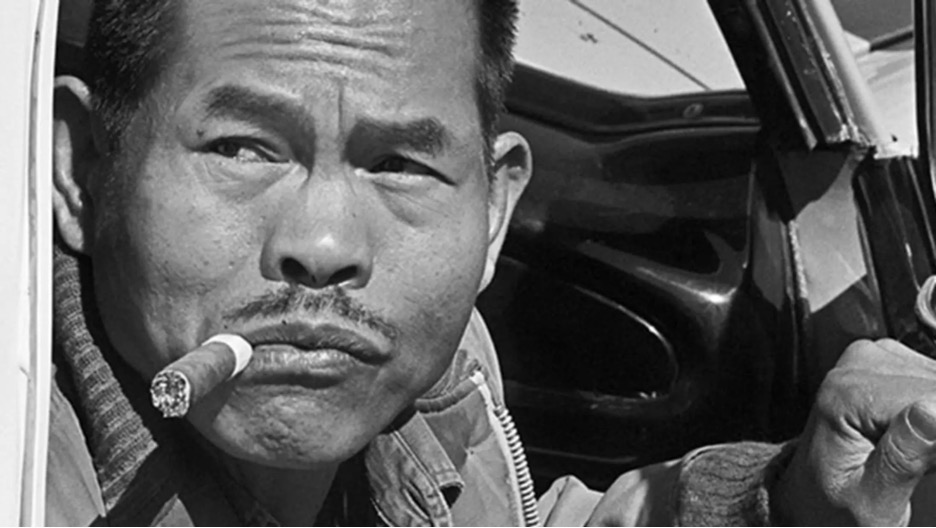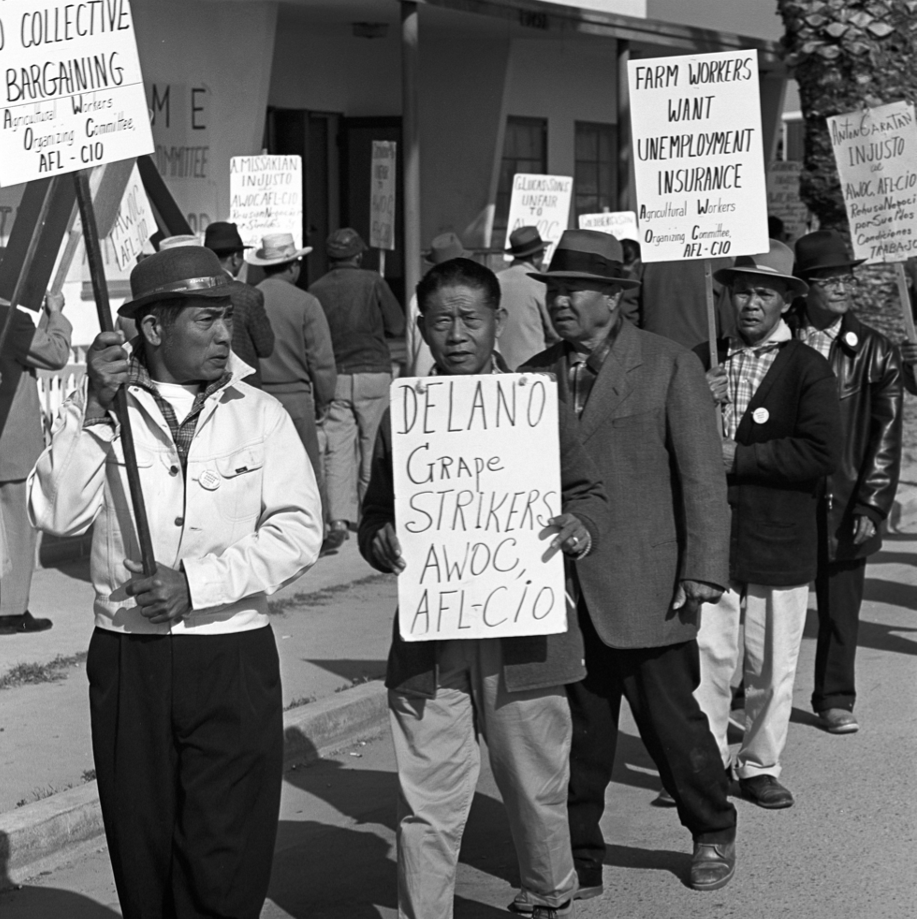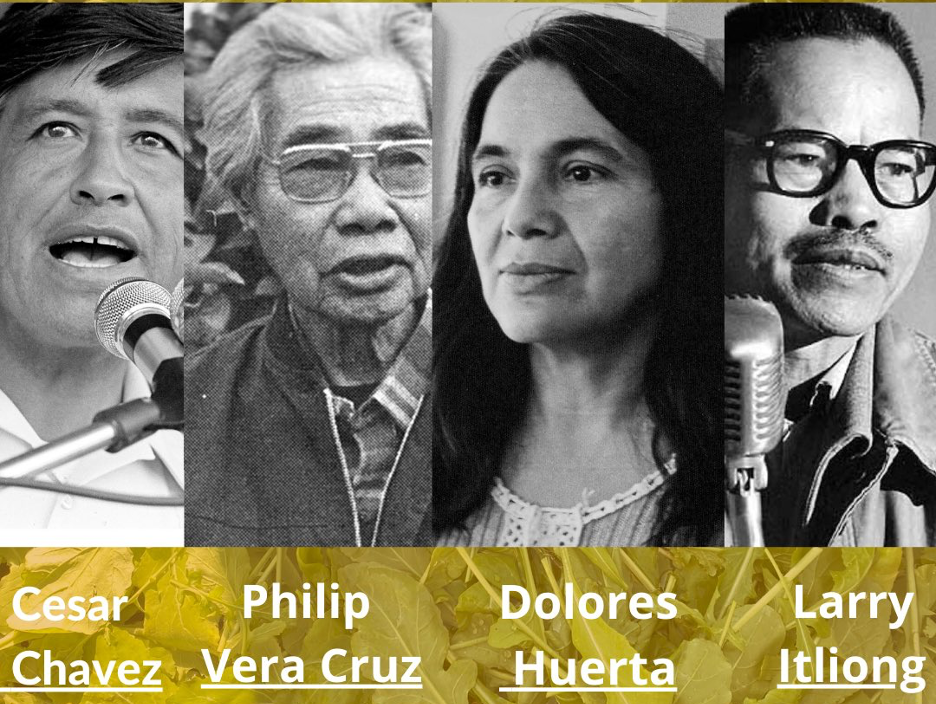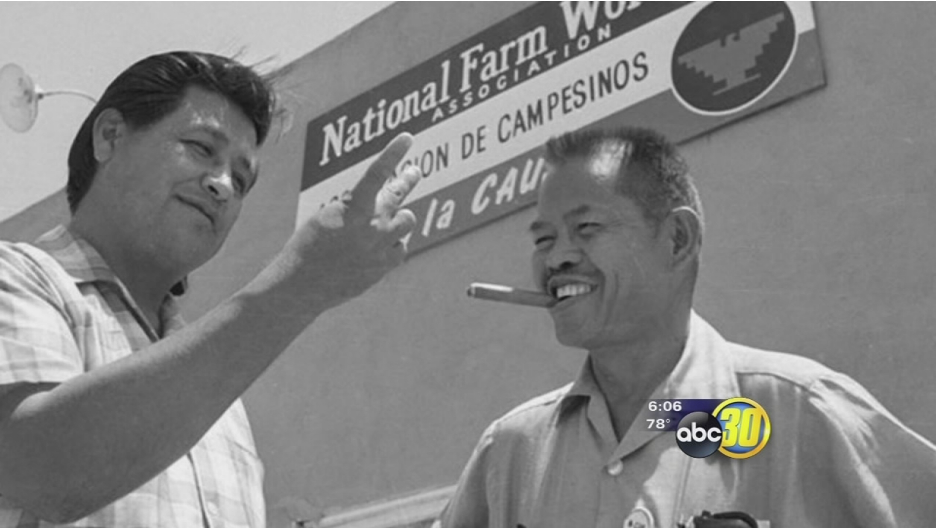|
|
The weekly newsletter of the Mexico Solidarity Project |
|
Every issue archived online at mexicosolidarityproject.org |
|
July 17, 2024 |
|
|
|
Unity! The Filipino-Mexicano Grape Strike |
|
Meizhu Lui, for the editorial team |
|
|
Larry Itliong: Photo: Welga Digital Archives |
|
Everyone in the labor movement and beyond has heard the cry, “Si, se puede!” (“Yes, we can!”), first uttered by Dolores Huerta of the United Farm Workers (UFW) in 1972. The names of Huerta and César Chávez, the UFW’s first president, are known everywhere in progressive households — probably in yours, right?
You’ve probably also heard the phrase, “Injustice anywhere is a threat to justice everywhere.” But do you know who said it first? It was Larry Itliong, a Filipino farm labor organizer instrumental in forming the UFW, and its founding vice-president. But few of us know Itliong’s name or the critical role he and the Filipino workers played in the historic Delano, California, grape strike.
Lorraine Agtang wants to change that. In fact, she says we must retell the story and put Filipino workers back into the picture. She recounted that building alliances across race, ethnicity, language and culture was hard; organizing Mexican and Filipino workers required different approaches, and the two groups held negative attitudes toward each other — fostered by the growers — and these attitudes had to be overcome.
But they did it, and it is that unity that is the main lesson of the Delano grape strike. Because if Mexicans and Filipinos hadn’t joined forces, our labor history would be far different: the grape strike broken, workers defeated, the UFW not born. And you and I would have been poisoned by eating grapes contaminated by pesticides and watered by the blood and sweat of immigrant workers.
|
|
For a deeper dive into current news and analysis in English, check out our media website. And definitely see the new English podcast ¡Soberanía! (Sovereignty) with José Luis Granados Ceja and Kurt Hackbarth. They entertain, while dismantling the lies and distortions about Mexico fed to us by the mainstream media. |
|
Don’t miss an issue! Sign up for a free Mexico Solidarity Bulletin subscription. |
|
|
Grape Strike! Filipino Workers Organize |
|
Lorraine Agtang is one of the few surviving Filipino grape strikers who kicked off the militant farmworker movement in 1965. She has dedicated her life to the struggles of farmworkers: organizing for the UFW, managing Agbayani Village for Filipino elders, and running programs for the children of farmworkers and community members. She still loves instilling pride in young people about the workers’ movement — especially the Filipinos’ contributions — that opened the door to the opportunities they enjoy today. |
|
|
Back in the 60s, while still a child, you worked in the vineyards in Delano, California. What was life like for you? |
|
We picked grapes in the fields with our parents to help support the family because no laws prohibited children from working in the fields at that time. In 1965, when I was 13, the Delano grape strike started on September 8. My first exposure to civil disobedience. It was scary! |
|
|
Lorraine, George and Frank Agtang, with Freddie Agbayani. Photo: Lorraine Agtang |
|
My father was Filipino, and my mother was Mexican. They met in southern Texas while working in the fields, and my father learned Spanish so he could communicate with my mother, who didn’t speak English. They married, moved to and settled in Delano, picking grapes. I and four of my siblings were born in the labor camp. The local doctor didn’t arrive until our heads popped out; that’s what happens to poor families without medical insurance. Delano was split by railroad tracks. The whites lived on the east side, and the Mexicans and Filipinos on the west side. But our camp was on the east side, a half-mile out, so I went to school with the white kids. One Sunday in church, the priest spoke about how Catholics should be responsible for the poor. His message was meant for the growers — but I thought he was talking to me! I took it to heart, helping the poor became my life’s mission. I married early and had three kids by the time I was 18. You couldn't go to school if you were pregnant back then, so I only finished 8th grade.
When did Filipinos arrive in the US and begin working as farm laborers? Did they work alongside Mexican migrants? |
|
My father was in the first wave of migrants coming to the US between 1920 and 1940. Many joined the military, but most became field laborers living in barrack-style housing on the grower’s land. They worked in a crew of up to 50, with a foreman in charge. The growers kept the Mexican and Filipino workers separated into different crews so they could be pitted against each other. They’d say, “The Mexicans pick more than you!” |
|
|
Filipino strikers: Photo: Nima Réja |
|
Filipino farm workers were the first to go on strike. Way down in Southern California, in Coachella, it gets very hot, up to 115 degrees. Because of the heat, the grapes rot quickly, and there were only 4 weeks to pick them. The Filipinos asked for a raise, and — because of the time crunch — the growers agreed.
So, the idea moved to Delano. But there, the workforce was huge, and the growers refused to raise wages. The Filipinos formed the Agricultural Workers Organizing Committee (AWOC). Its leaders were Larry Itliong, Pete Velasco, Philip Vera Cruz, and Andy Imutan. Itliong wasn’t a worker himself; he was a labor contractor who got Filipino workers hired at specific farms. Foremen and community people also joined the workers because, no matter their position, they identified with the situation of their fellow Filipinos.
On September 8, 1965, AWOC’s 2000 members walked out of the fields, and the historic Delano Grape Strike began!
AWOC leaders knew they couldn’t win the strike; many Mexicans crossed the picket lines. They went to César Chávez, who had founded the National Farm Workers Association, and asked him to join the strike. César asked the members to join, but some Mexican workers said no. So César said, “OK, I’ll quit, and I will join the Filipinos.” Quickly, the members changed their minds. |
|
|
4 leaders of the newly formed UFW: Photo: Nima Réja |
|
When the Filipinos and Mexicans joined together, it was a healing moment for me personally — Filipinos didn’t think I was Filipino enough, and Mexicans didn’t think I was Mexican enough! But that unity was also crucial to the strike, and that’s how the United Farm Workers union was born. In 1966, the Filipino and Mexican organizations merged. César Chávez was president; Larry Itliong was vice president; Philip Vera Cruz and Dolores Huerta were board members. |
|
|
Larry Itliong and César Chávez: abc30, united farmworkers association/1045164 |
|
After five years of the strike, protest marches, demonstrations in Sacramento and the national grape boycott, the first agricultural workers contract was finally signed in 1970. |
|
Was life particularly hard for the older generation of Filipino workers?
We call them “manongs,” or “older brothers.” The manongs had no families. At the time, anti-miscegenation laws prevented Filipinos from marrying white women, and no single Filipina women lived in the area, except prostitutes. The manongs lived in shacks in the camps in miserable conditions; some didn’t speak English and didn’t know how to use a bank. Then, after the strike started in 1965, the growers kicked the manongs out of the camps. Regardless, the manongs were on the picket lines every day, forming the backbone of the strike. |
|
But in 1973, after the boycott ended, the United Farm Workers built the Agbayani Retirement Village to give the manongs a comfortable home for their final years. Many volunteers from all over California came to help build the village, including farmworkers and Filipino college students who came on weekends and in the summer, and it was an education for those young folks! Hearing the stories, many had tears in their eyes, and many later became advocates. For example, they won the addition of Filipino history to the state high school curriculum. Agbayani had 62 units, a community dining room, a Filipino cook, a vegetable garden and a nearby clinic. Other residents became family in this safe and beautiful place. I was the manager of Agbayani for the first year after it opened. But then, in 1976, I became a union organizer. All the Manongs have died now, and Agbayani Village is a National Park Historical landmark. We'll have a big 50th anniversary celebration there on October 19, 2024. |
|
|
Manongs at Agbayani Village who participated with AWOC and the UFW, Photo: WelgaArchive - Bulosan Center for Filipino Studies/Lorraine Agtang collection |
|
What an amazing life you’ve had! What are the lessons you leave with the farmworker kids in the youth programs you ran for 30 years?
The importance of worker unity. If the Filipinos and Mexican workers hadn’t joined together, they wouldn’t have won. I want Filipino students, male and female, to know the crucial role Filipinos played in the movement and in the creation of the UFW. While César is well known as its founder, the Filipinos who were also founders have often been forgotten. Their stories must be included, or the significance of the Mexican-Filipino alliance will be lost. For me personally, the union gave me tenacity: you can demand what you want and need, you can’t give up. As a Hispanic Filipina woman, I learned from César that you are equal to anyone. Never feel like you are lesser. |
|
|
|
|
The Terrible Ignorance of Norma Piña |
|
|
Mexico City based freelance writer and photojournalist José Luis Granados Ceja previously spent time as a staff writer for teleSUR, and currently works with Venezuelanalysis. His writing on contemporary Latin American democratic struggles can be followed on X (Twitter): @GranadosCeja. |
|
|
“Given the national situation, we must ask ourselves: what have we failed to do so that throughout this national journey [...] we hear from all of them, time and again, that justice is distant, inhumane, that justice is a nightmare?”
You’d be forgiven if you thought this quote came from President Andés Manuel López Obrador, President-elect Claudia Sheinbaum, or any Morena activist, given that the party is currently pushing for a once-in-a-generation overhaul of the country’s judicial branch through constitutional amendment.
But you’d be mistaken. The quote actually comes from Supreme Court President Norma Piña, who now embodies the opposition to judicial reform. She made this comment during her interview with El País newspaper following the National Meeting for a Security and Justice Agenda, which was organized by the judicial branch itself. It was billed as a wide-ranging dialogue for “people interested in improving security and justice in Mexico.”
Elsewhere, Piña expressed surprise that instead of talking about the “separation of powers” and “judicial independence,” the Mexican people were far more interested in talking about their rights and the experiences of victims with the justice system.
What terrible ignorance from the Mexican Supreme Court president!
How is it that Piña never realized before that most people who have ever interacted with the country’s justice system are left with a bitter taste in their mouth?
Sheinbaum’s massive election victory on June 2 was largely due to voters seeking to reward Morena for its track record in office; but it’s also due to the population consciously and intentionally responding to López Obrador’s call for a supermajority, precisely to give his party the legislative tools to overhaul the judiciary. Morena conducted surveys and found that more than 80 percent of the population back a major change to the judiciary.
Why? Besides a legacy of widespread accusations of corruption and failing to deliver justice to victims who have seen their abusers walk away with impunity, the judiciary has made questionable rulings favoring corrupt actors and has consistently sided with the old neoliberal order.
Astoundingly, critics such as Mariana Velasco-Rivera, assistant professor at the Maynooth School of Law and Criminology, claim that Morena sowed this negative attitude toward the judicial branch, and that the AMLO government was “the only one peddling the idea that the judiciary is broken [and] untrustworthy.” But clearly, Morena did not need to “sow” discontent.
Critics of Morena's judicial reform proposals don’t appreciate the wide-scale political change that the “Fourth Transformation” is pursuing. Far from being an example of Morena’s “creeping authoritarianism,” it is about creating a judicial system responsive to victims. Crucially, it’s also about defeating the neoliberals taking refuge inside the judicial branch, one of the country’s remaining conservative strongholds. Without reform, the judicial branch would likely continue to sabotage the “Fourth Transformation” of Mexico.
Thankfully, voters gave the Morena coalition the votes necessary to transform the justice system. After the election, Norma Piña sharply departed from her usual condescension and is now apparently contrite and willing to talk — a transparent effort to keep her position and power. Now, as even she admits, given Morena’s supermajority in Congress, judicial reform will happen.
May the “nightmare” soon be over. |
|
|
|
|
Recent news reports and commentaries, from progressive and mainstream media, |
|
Pablo Meriguet, What is AMLO’s judicial reform and why is the Mexican right uniting to try and stop it People’s Dispatch. The reform, which has caused significant resistance from the right, proposes the election by popular vote of all judges, the separation of responsibilities of the Judiciary Council, and the establishment of new rules for judicial proceedings
Alejandro Ruiz, ¿Caminamos hacia una integración regional en América Latina? Pie de Página. En medio de una crisis diplomática entre México y Ecuador, la Cumbre de Estados Latinoamericanos y de el Caribe volvió a aparecer en el mapa político de la región, y con esto, reavivó el debate sobre si es posible lograr una articulación de lo que Bolívar llamó la Patria Grande. ¿Qué posibilidades hay de esto?
Dave Mass, Hundreds of Tech Companies Want to Cash In on Homeland Security Funding. Here's Who They Are and What They're Selling Electronic Frontier Foundation. Whenever government officials generate fear about the U.S.-Mexico border and immigration, they also generate dollars–hundreds of millions of dollars–for tech conglomerates and start-ups.
Viri Ríos, Ahora o nunca Milenio. Personalmente le tengo más miedo a la debilidad que a la capacidad y me parece que éste es un momento único para demandar que la coalición gobernante utilice sus capacidades extraordinarias para reformar todos aquellos recovecos que han empoderado monopolios, debilitado al trabajador y al pequeño empresario, limitado la capacidad del estado para cobrar impuestos, incentivado la corrupción y promovido la discriminación y el clasismo.
Josh Boak, Biden administration to tax foreign-made steel and aluminum imports routed through Mexico Associated Press. The new taxes on steel are meant to address the evasion of tariffs by China, the dominant producer of more than half of the world’s steel. The aluminum taxes would also hit production based in China, Belarus, Iran and Russia.
Gerardo Hernández, Salarios contractuales alcanzan el crecimiento real más alto de la historia El Economista. En el cierre de la primera mitad del año, las revisiones salariales del personal sindicalizado acumularon 18 meses con saldos positivos en términos reales y alcanzaron una cifra histórica para un período enero-junio.
Andrew Baker, Morena Landslide Could Allow Major Energy Reforms Before Mexico’s AMLO Leaves Office Natural Gas Intelligence. US capital fears Mexican sovereignty.
Jorge A. Pérez Alfonso, Mario Delgado en la SEP representa una afrenta al magisterio: Sección 22 La Jornada. “La designación de Delgado Carrillo al frente de la SEP es una afrenta al magisterio democrático que tiene memoria y no olvida que fue uno de los principales impulsores de la Reforma laboral-educativa de Enrique Peña Nieto en el 2013, cuando formaba parte del Pacto por México” acusaron.
Diego López Colín, Communism is ‘imminent’ in Mexico, bishop says Catholic News Agency. It looks like things are advancing far more rapidly than expected!
Kau Sirenio, La colonia proletaria Rubén Jaramillo: una historia de resistencia y revolución Pie de Página. La historia de la colonia proletaria Rubén Jaramillo, en Morelos, sigue siendo desconocida para gran parte de la sociedad. Los esfuerzos por rescatar la memoria de esta organización no han sido pocos, y a 50 años de su fundación, un nuevo libro retoma las vivencias de quienes erigieron este proyecto revolucionario y de resistencia. |
|
|
|
|
The Mexico Solidarity Project brings together activists from various socialist and left organizations and individuals committed to worker and global justice. We see the 2018 election of Andrés Manuel López Obrador as president of Mexico as a watershed moment. AMLO and his progressive Morena party aim to end generations of corruption, impoverishment, and subservience to US interests. Our Project supports not just Morena, but all Mexicans struggling for basic rights, and opposes US efforts to undermine organizing and Mexico’s national sovereignty.
Editorial committee: Meizhu Lui, Bruce Hobson, Agatha Hinman, Victoria Hamlin, Courtney Childs, Susan Weiss. To give feedback or get involved yourself, please email us! |
|
Subscribe! Get the Mexico Solidarity Bulletin in your email box every week. |
|
Web page and application support for the Mexico Solidarity Project from NOVA Web Development, a democratically run, worker-owned and operated cooperative focused on developing free software tools for progressive organizations. |













